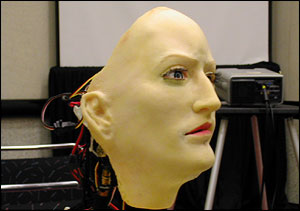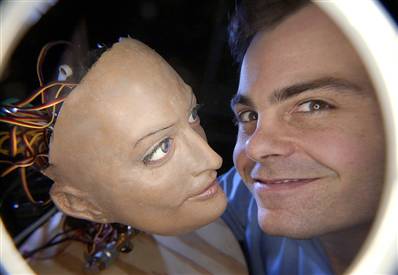

 |
 |
Researchers in robotics, and in computer animation, have lately been bedeviled by a sort of optical illusion first predicted by Japanese researcher Masahiro Mori in 1978. Mori spoke of a "Valley of the Uncanny." A better term, perhaps, is "Zombie Effect." The idea is this: suppose I try to construct a robot which people can hopefully relate to because its face is very like that of a human. Or suppose I try to make an entirely computer animated film in which many human characters appear. What Mori pointed out, or predicted, is that the closer the robot or animated figure comes to resembling a real human, the creepier and "deader" it should look. Many researchers hotly deny that any such effect exists; but its reality was unexpectedly demonstrated by a 2004 animated film, POLAR EXPRESS. Nearly every adult who saw the film complained that the human characters looked "dead"--- their eyes were lifeless, their opened mouths revealed only dark pits with a generic teethlike bar, and their general expressions from shot to shot had the laxness seen in a corpse whose muscles have been frozen by death. One reason is that the animation was guided by motion capture on the faces of actors; while movement of facial muscles was captured, movement of eyeballs, teeth and tongues was not.
Compare the masklike, crude computer animated faces at the left below with the "realistic" computer-animated child from POLAR EXPRESS seen at right below. There is no emotional reaction from most people to the crude faces, but the child looks disturbingly creepy, even though this is supposed to be a sympathetic character for kids to identify with. I will let you decide if robotics researcher Dave Hanson of UT Dallas has managed to avoid the pitfall with his robot face K-bot, shown in three views (one with Hanson) at the top of this page. Click on the images of K-bot for more information.
 |
 |